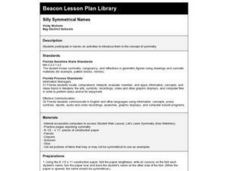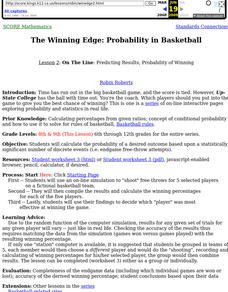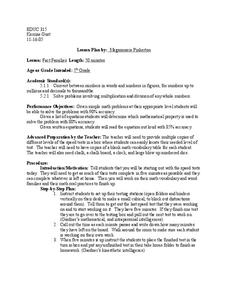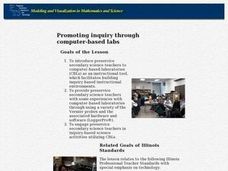Curated OER
Trends of Snow Cover and Temperature in Alaska
Students compare NASA satellite data observations with student surface measurements of snow cover and temperature. They practice data collection, data correlations, and making scientific predictions.
Curated OER
Silly Symmetrical Names
Fourth graders participate in hands-on activities to introduce them to the concept of symmetry. They make a silly symmetrical picture out of their names after gluing them onto a larger sheet of construction paper. This is a really...
Curated OER
Inchworm
Learners discover the basic concept of measuring. In this mathematics relationship lesson plan, students identify length, volume, weight, time and area in order to measure different units. Learners measure items using different units.
Curated OER
An Introduction to Simple Machines
Students investigate simple machines and their uses in everyday life. In this scientific method lesson, students examine physical tools such as wedges, screws, and levers using a "how does it work" approach. Students complete...
Curated OER
The Winning Edge: Probability in Basketball: Lesson 2
Students calculate the probability of a desired outcome based upon a statistically significant number of discrete events (i.e. endgame free-throw attempts). They participate in an online simulation of basketball free throws.
Curated OER
Weather Graphs
First graders use their knowledge of weather symbols to organize and construct a graph of the daily weather for one month. Each student have a chance to give the daily weather report using Sammy's Science House Computer Software.
Curated OER
Family Cookbook
Second graders, in groups, produce a Family Cookbook by bringing recipes from home.
Curated OER
ExplorA-Pond:4th Grade Surface Area
Fourth graders estimate the surface area of a pond using the chance method and the estimation method. They complete a graph and a short report comparing the results of the two methods.
Curated OER
Is the Price Right?
In this money management, students study inflation. Students complete the given table filling in the 15 spaces for the prices of items for three different given years.
Curated OER
Multiplication and Exponents
Students write values as both standard and exponential forms. In this exponential form lesson plan, students solve multiplication of exponents problems. Both application and drill and practice formats are presented.
Curated OER
U Boat Hunt
Learners recognize patterns and sequences in numbers. In this geometry lesson, students create rules to define the sequences and patterns they obsere. They translate coded messages as they dicuss navigational terms.
Curated OER
Data Days
Sixth graders practice collecting, organizing and displaying data. They create circle, bar, line and picto graphs. They analyze data in small and large sample groups.
Curated OER
Marble Game
Learners practice counting groups of items of six or more. They create equivalent sets.
Curated OER
Fact Families
Fifth graders explore fact families. They solve simple math problems. Students determine which mathematical property is used to solve the given problem. They are given five minutes to complete as many mathematical facts as possible.
Curated OER
Satellite Tracker
Learners use satellite tracking software to monitor different satellites. They predict and graph the motion of the space station. They create a 3-D display of its path and share it with the class.
Curated OER
Students Speak Up
Students share the ways they use technology at school and at home. In groups, they discuss how their study of math, science and technology is helping to prepare them for future jobs. They share their findings with the class and develop...
Curated OER
Sorting Pond
Pupils practice balancing while learning the classifications of different animals
Curated OER
What Does It Take?
First graders study the attributes of circles, squares, triangles and rectangles. They sort shapes that are the same and those that are different into groups.
Curated OER
50 State Quarter Game
Learners, using their knowledge of place value and number sense, play this counting game in small groups, or as a whole class, to see who be the first person to reach 50 cents.
Curated OER
Calculate the Answer
Students solve basic multiplication or addition facts using a calculator and product cards. They draw a card, read the sum or product, and press single digits on the calculator to display the number on the card.
Curated OER
Promoting Inquiry Throught Computer-Based Labs
Student Teachers are given the opportunity to examine how to use a computer-based laboratory for inquiry. The practice is done to teach future teachers how to use these tools so they can be ready for use in the classroom environment.
Curated OER
How Long is a Slinky?
Students take part in a variety of measurement tasks. Students measure the length of a slinky. Students work out how many slices of tomato will fit around the edge of a pizza. Students measure the label from a can accurately.
Curated OER
Surf's Up!!!
Second graders complete a student worksheet to form multiplication facts that correspond with each site.
Curated OER
Geometric Shapes at the OK Corral
Students explore regular geometric shapes. In this shapes lesson, students investigate geometric shapes in the world around them. Students differentiate between regular and irregular shapes.

























